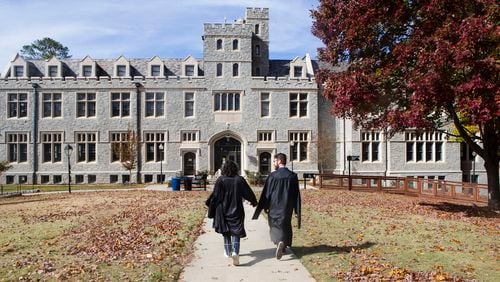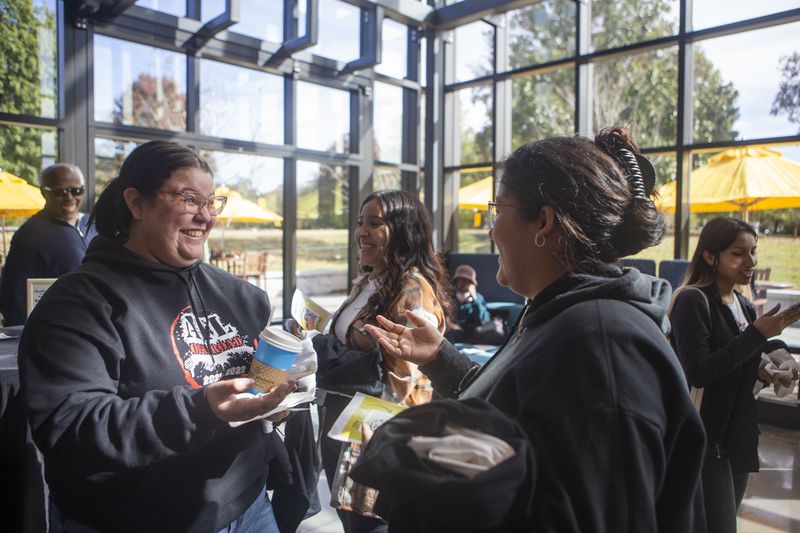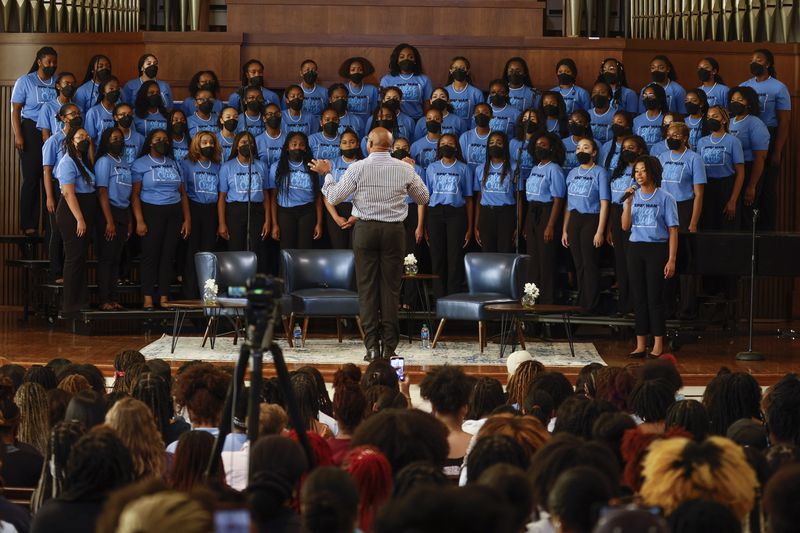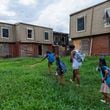Something unprecedented happened this fall at Oglethorpe University, where stately Gothic revival architecture gives an academic gravitas to the private Brookhaven campus.
A record number of first-year students — 425 — enrolled at the school, pushing Oglethorpe to its highest student count since its founding in 1835. This year’s total enrollment of 1,494 is up only a few dozen over last year, but leaders are optimistic as they look to grow at a time when many colleges are suffering declines.
Oglethorpe’s president believes its close-knit campus, student supports such as mental health services and diversity are drawing students.
“A small liberal arts college gives what many students need right now, particularly after the pandemic,” said Nick Ladany.
The state’s private and public colleges experienced mixed success this fall in pulling pandemic-weary students back to their campuses. Enrollment at the University System of Georgia’s 26 public colleges fell for the second consecutive year, down 1.8% compared to the prior year. Nationally, college enrollment declined by 1.1%.
Enrollment grew at three of Georgia’s four prominent public research universities, with Georgia Tech leading the pack. But generally, the smaller state schools with a regional focus struggled more. Several of Georgia’s private colleges reported growing interest as they made it easier to apply, a move that most of the state’s public schools also made.
Experts said higher-wage jobs have attracted would-be students to pick work over studies. Uncertainty brought on by the COVID-19 pandemic is still having an impact.
Fewer students means tighter budgets since the state system’s funding is enrollment-based. USG officials are meeting with college leaders to “align their resources with both the demand for specific academic programs and their strategic priorities,” said a system statement. They’ll do so using “a data-based approach to find solutions and make the biggest impact for the students and taxpayers of Georgia.”
Chancellor Sonny Perdue put it more bluntly to the Georgia Board of Regents in November: “When you don’t have as much sales, you’re going to have fewer people.”
Freshman enrollment has fallen by about 7%, or more than 3,800 students, since fall 2020. Long-term, the University System is anticipating fewer Georgia high school graduates due to lower birthrates.
Over the last five years, undergraduate numbers at the state’s public colleges fell by about 3% to 262,489 students as of this fall. Graduate and professional student numbers shot up 28% in that span, though 2021 to 2022 saw only very modest gains.
Some metro Atlanta private schools fared well. Oglethorpe’s president said students have picked the school because small classes allow them to forge relationships with professors, of value after many felt disconnected by the pandemic. Its diversity is another draw. About 40% of students are the first in their families to go to college; 60% are students of color, he said.
Credit: Christina Matacotta
Credit: Christina Matacotta
Oglethorpe, like many colleges, dropped the admissions requirement to submit ACT or SAT scores. That change also contributed to a surge in applicants at Emory University and Spelman College.
The last two years brought the biggest applicant pools in Emory’s history, said John Latting, dean of admission. The private university’s enrollment nudged up slightly to 15,909 students this fall.
Many flagship public universities and nationally renowned private colleges have been “doing just fine from an enrollment standpoint” in recent years, he said. Latting said Emory continues to see more geographic and racial diversity among prospective students.
Applications to Spelman increased by nearly 50% since fall 2019, surpassing 13,600 in the most recent year. This fall’s enrollment of 2,378 is down slightly compared to last fall, when numbers jumped due to a large first-year class.
Spelman officials want to get back to their ideal size of 2,100 to 2,200 students, a number based on campus facilities and academic resources.
Credit: Natrice Miller / Natrice.Miller@ajc.com
Credit: Natrice Miller / Natrice.Miller@ajc.com
Ingrid Hayes, Spelman’s senior vice president for enrollment management, has seen a “heightened interest” because of the school’s successful graduates, academic reputation and the “sense of belonging.” National conversations about social issues also led some students to prioritize attending historically Black colleges.
“These students are coming of age when many of them feel compelled to speak up and offer solutions,” Hayes said.
Many of the state’s smaller or regionally focused schools struggled with enrollment. Of the state’s four comprehensive universities — Georgia Southern, Kennesaw State, West Georgia and Valdosta State — only Kennesaw State had a slight uptick.
In a written statement, President Kathy Schwaig said the gains reflect “our focus on the academic needs of our students and our commitment to provide world-class degrees in areas in high demand in the marketplace.”









